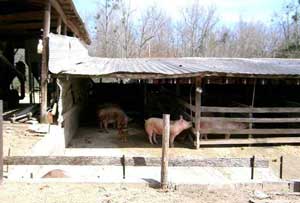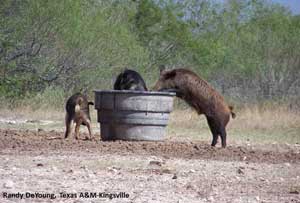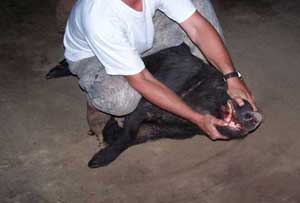Wild Pigs and Disease
 Domestic swine operations with poor facilities and facility maintenance
are at a greater risk of disease transmission from wild pigs.
Domestic swine operations with poor facilities and facility maintenance
are at a greater risk of disease transmission from wild pigs.
Wild pigs are known carriers of at least 45 different parasites (external and internal) and diseases (bacterial and viral) that pose a threat to livestock, pets, wildlife, and in some cases, human health. Also of concern are foreign animal diseases (FAD): those that have never been in North America or those that were present at one time but have been eradicated during the last 100 years. FADs are of particular concern because they are highly contagious and the continued expansion of wild pig ranges will only help to facilitate their spread if (re)introduced.
 Wild pig use of feed troughs and watering tanks is a potential disease
threat to
domestic livestock.
Wild pig use of feed troughs and watering tanks is a potential disease
threat to
domestic livestock.
Animal Health
The threat of disease transmission from wild pigs to other animals is probably of greatest concern to the livestock industry. Several of these diseases are swine specific (both wild and domestic), but others can affect cattle, sheep, goats, dogs, horses, and several species of native wild mammals. Infectious diseases that are significant to livestock and other animals include
- Pseudorabies Virus (PRV)
- Swine brucellosis (Brucella suis)
- Bovine tuberculosis (TB)
- FADs
- African swine fever
- Classical swine fever (Hog Cholera)
- Foot and Mouth Disease
Public Health
 Always wear gloves when handling wild pigs.
Always wear gloves when handling wild pigs.
Diseases that are transmissible from animals to humans are called zoonotic diseases. Many of these diseases are transmitted through contact with bodily fluids and handling or ingestion of infected tissues. Diseases can also be transmitted indirectly through contaminated water sources and possibly, through ticks. Zoonotic diseases transmissible by wild pigs include
- Leptospirosis
- Brucellosis
- E. coli
- Salmonellosis
- Toxoplasmosis
- Rabies
- Swine Influenza viruses
- Trichinosis
- Giardiasis
- Cryptosporidiosis
Disease Prevention
"An ounce of prevention is worth a pound of cure." Follow these simple measures to avoid infection when handling or field dressing wild pigs:
- Wear latex or nitrile gloves; pathogens can enter the body through cuts on hands or torn cuticles.
- Avoid splashing body fluids into your eyes or mouth.
- Wash your hands thoroughly after field dressing and processing meat, even if you wear gloves.
- Thoroughly clean and disinfect work areas and tools used to dress and butcher wild pigs.
- Dispose of animal remains, used gloves, and other materials properly. Animal remains should not be left for scavengers, nor should they be fed to dogs. Depending upon your jurisdiction, several methods of appropriate disposal may be considered. Check with your local health department or state wildlife agency.
- Follow correct refrigeration, freezing, and cooking methods. Freezing to 0°F will render bacteria inactive but will not destroy them; once thawed, bacteria can again become active. Also, do not rely on home freezing to destroy Trichina and other parasites. Thorough cooking will destroy all parasites and kill bacteria. Cook wild pork to an internal temperature of 165°F to 170°F.

